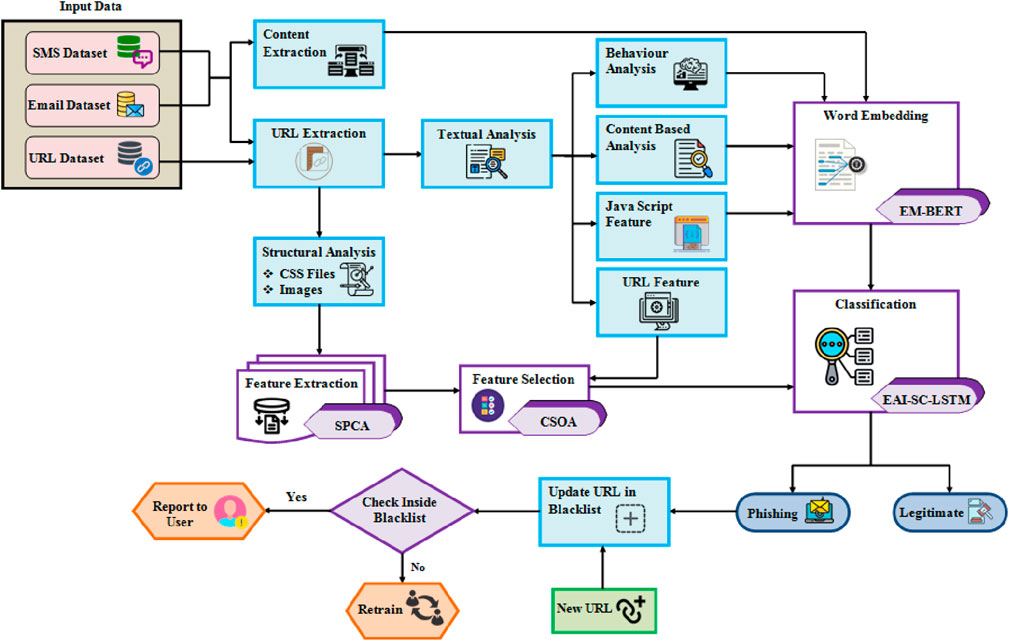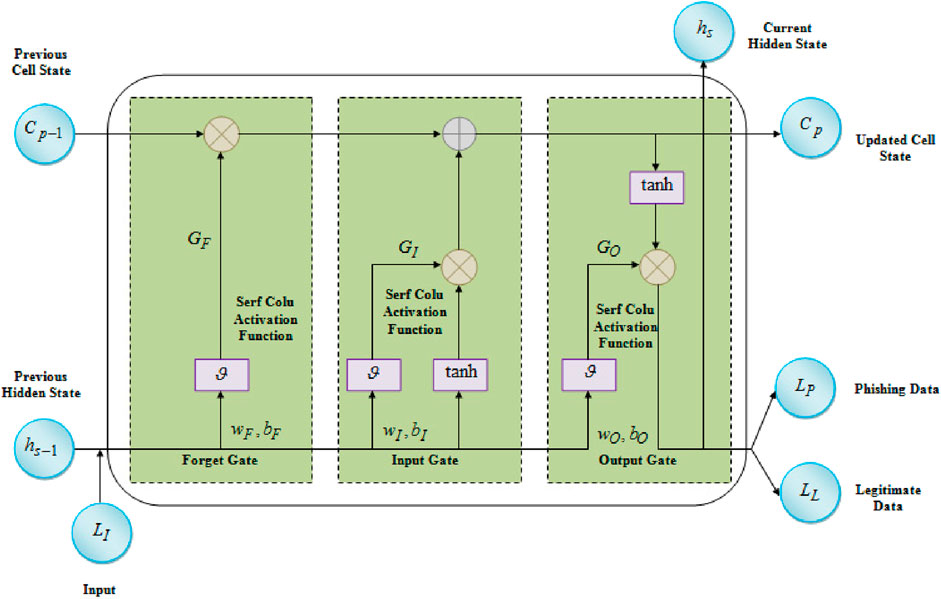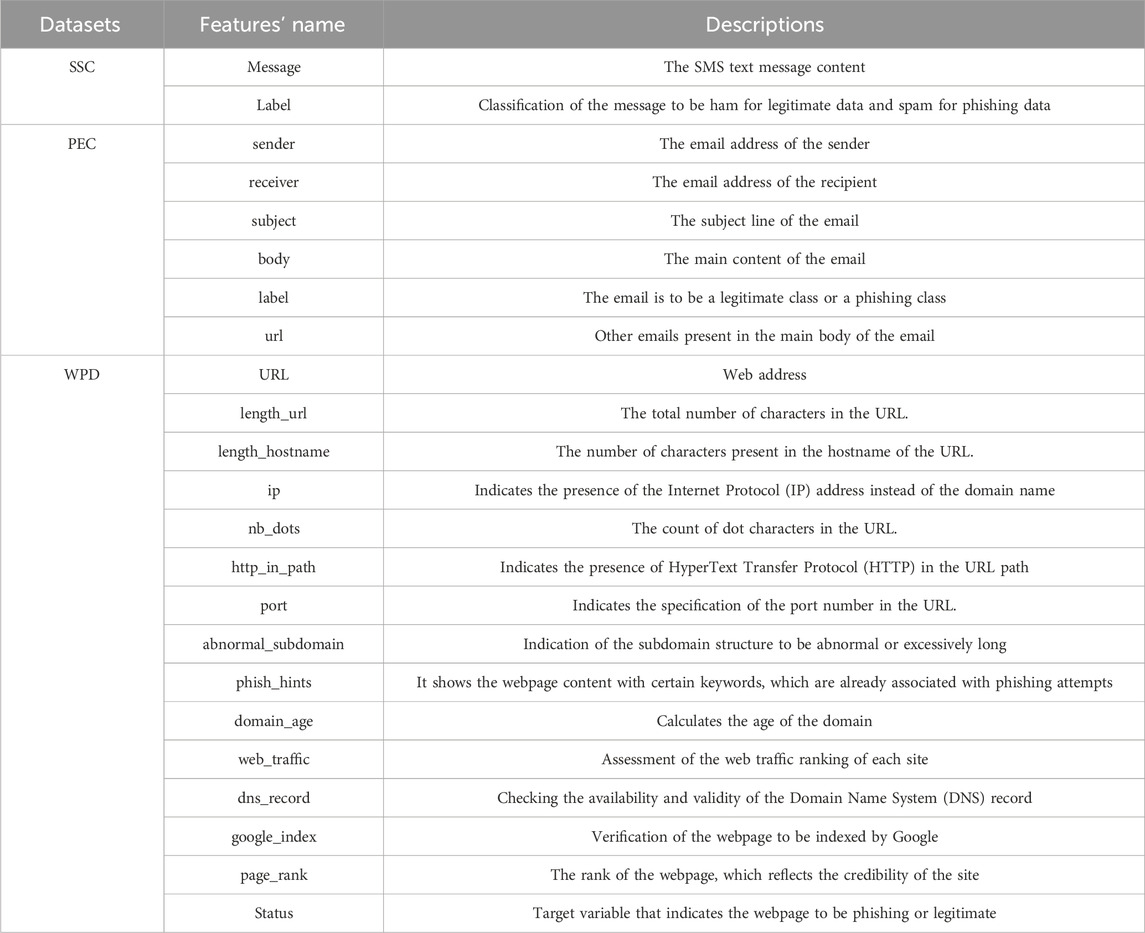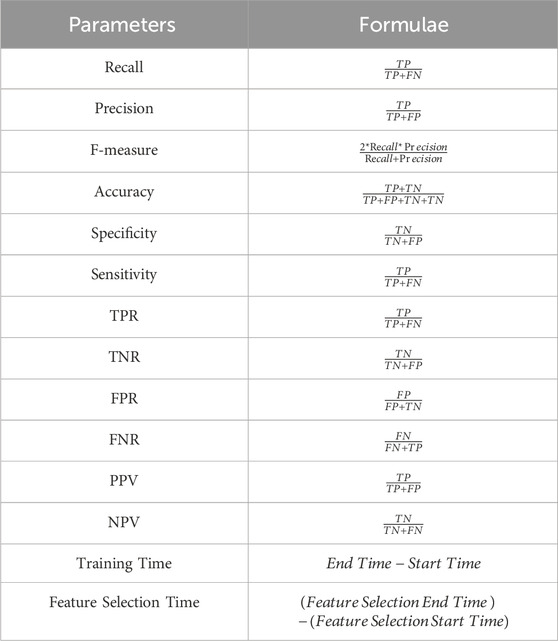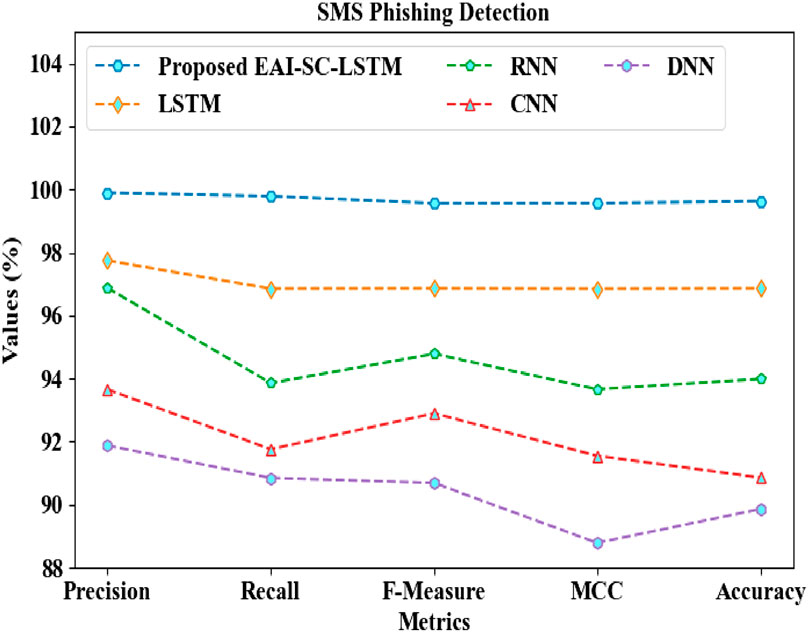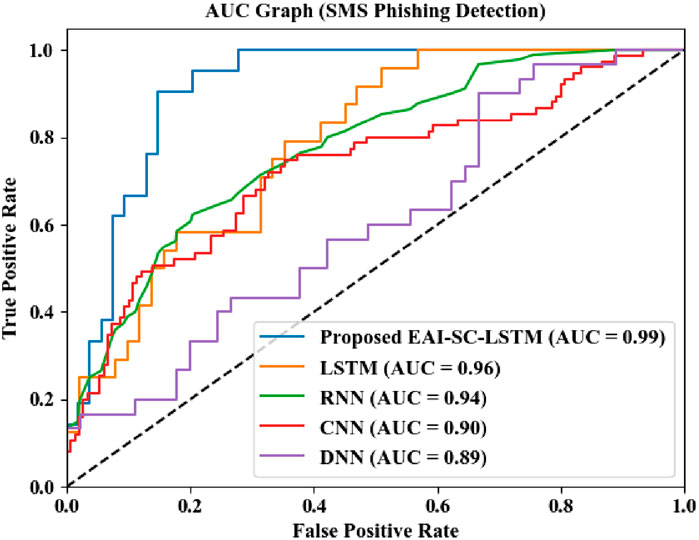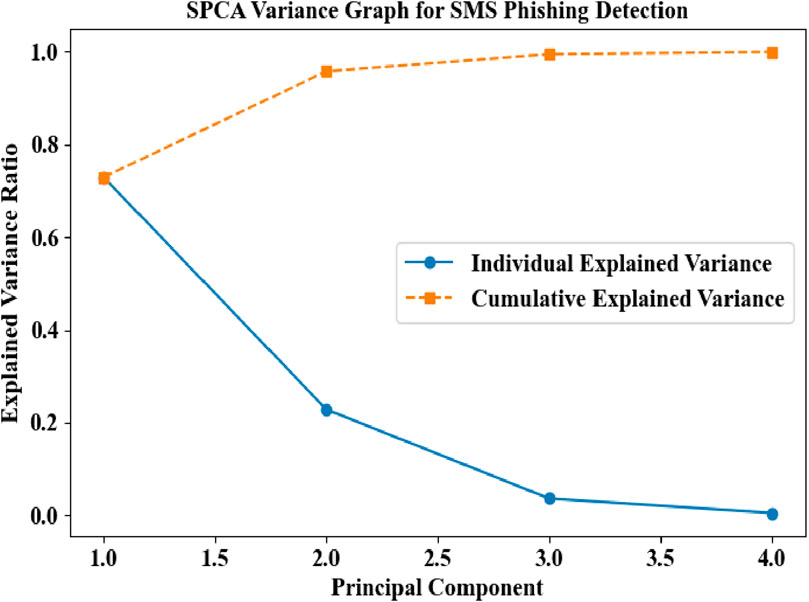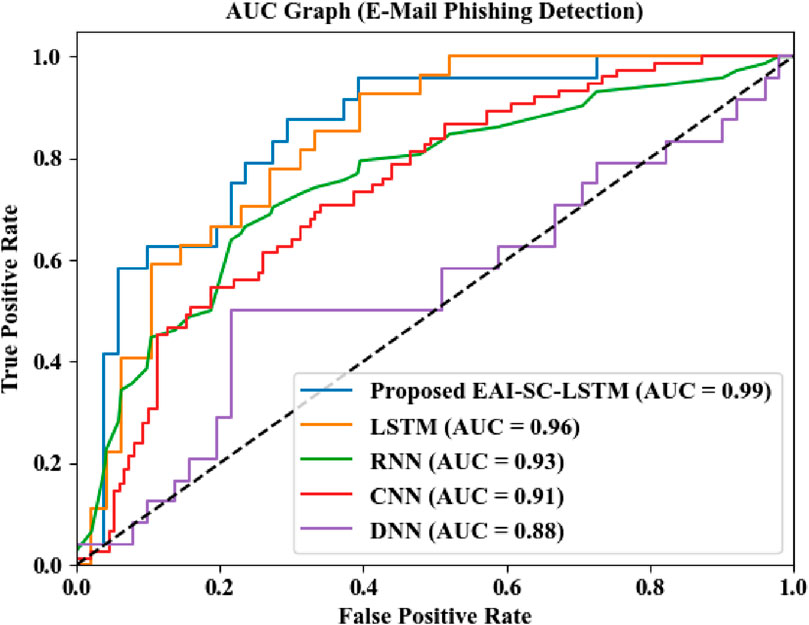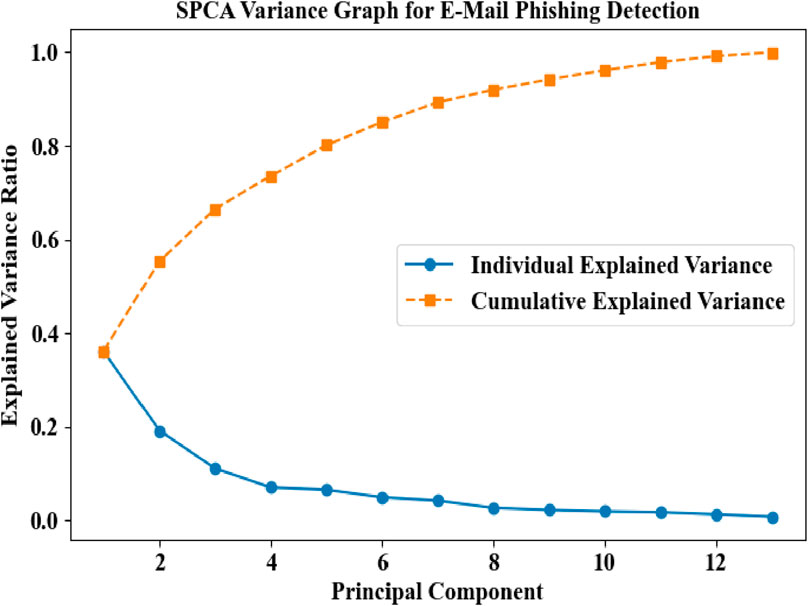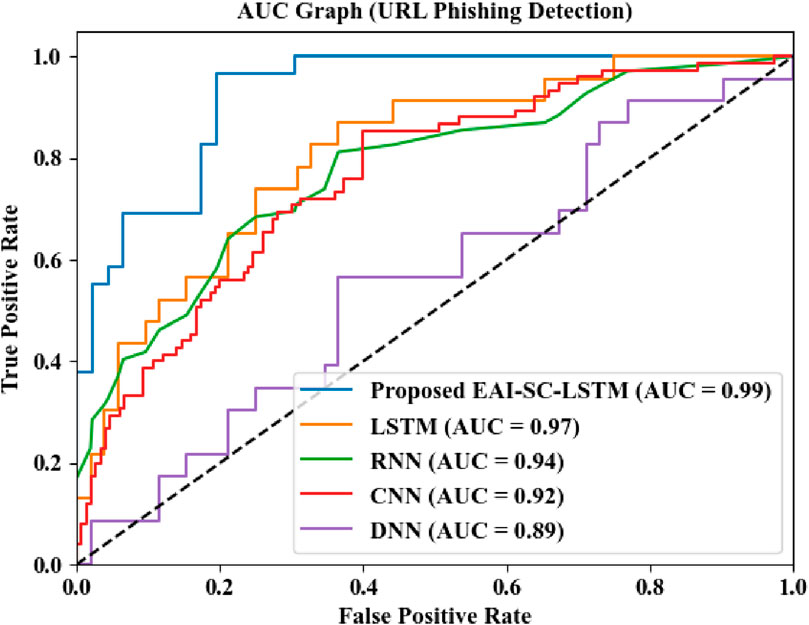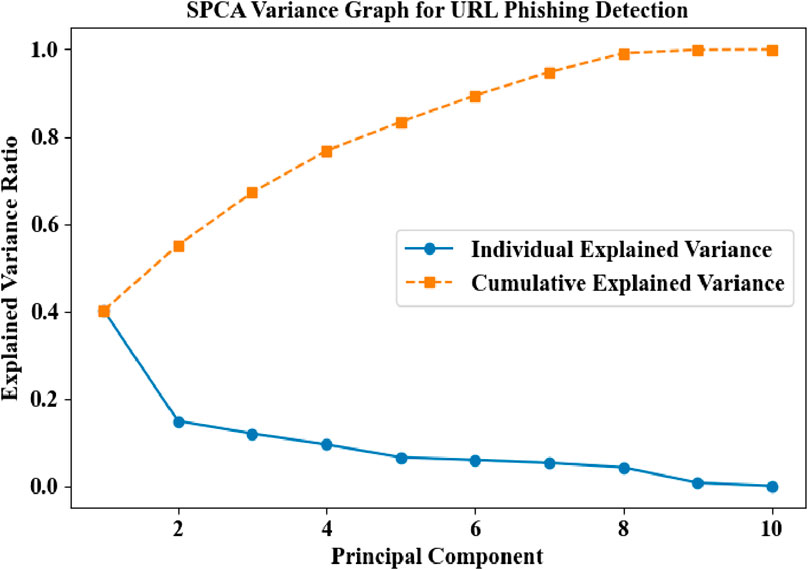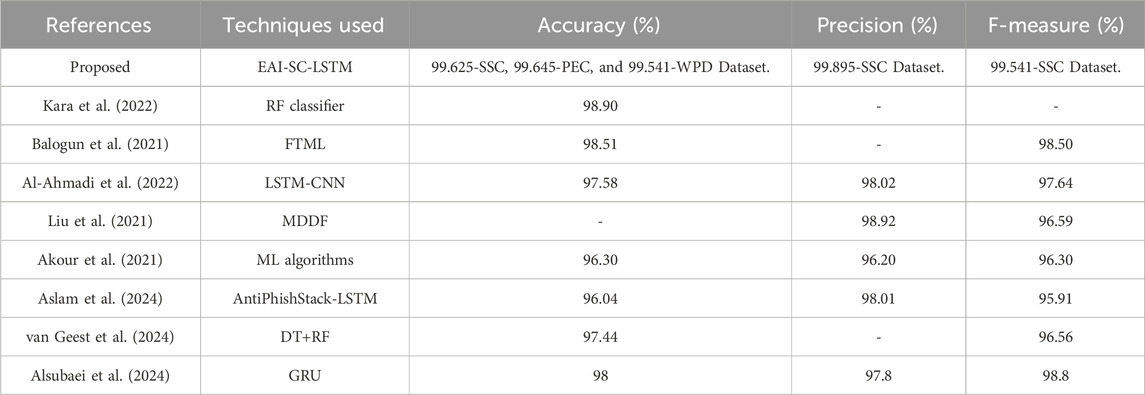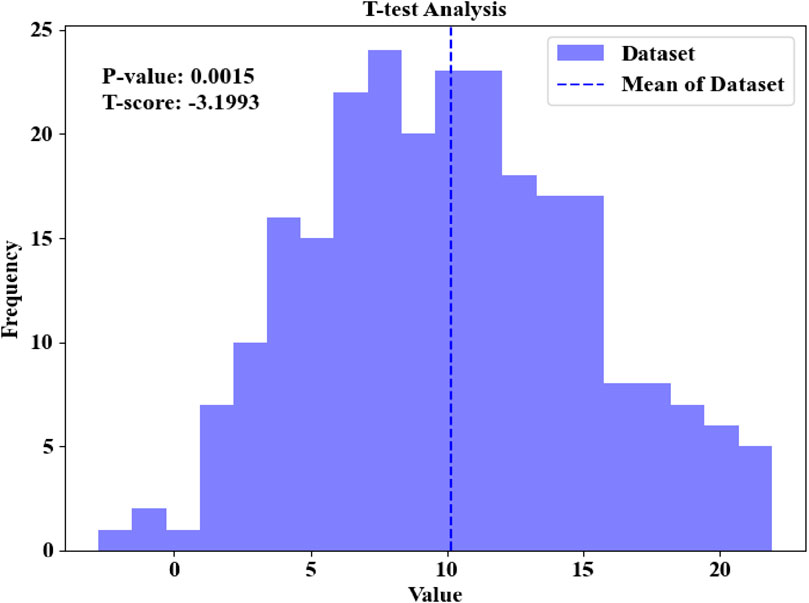- Department of Computer Science and Engineering (CSE), Vel Tech Rangarajan Dr. Sagunthala R&D Institute of Science and Technology, Chennai, India
Introduction: The rapid growth of advanced networking causes a significant increase in malicious threats to website data for accessing user information via phishing attacks. For the detection of phishing attacks, many works are developed based on a single data source. But, detecting the phishing attacks of different web sources was not concentrated in any of the existing works. Thus, multiple data sources, including SMS, E-Mail, and URL links, are used in this paper to detect and mitigate phishing attacks.
Methods: Initially, the input data is collected from the SMS, E-Mail, and URL datasets. The contents and URLs are extracted from the datasets. Next, the textual analysis, including behavioral analysis and structural analysis, is carried out on the extracted URL. Moreover, by utilizing the Entropy Macqueen-based Bidirectional Encoder Representations from Transformers (EM-BERT) algorithm, the contents extracted from SMS and E-Mail datasets and the textually analyzed characters of the URL are transformed into vector form. Simultaneously, the CSS files and images are obtained from the URL dataset. Then, by utilizing Spherical Principal Component Analysis (SPCA), the features are extracted. Further, the optimal features are chosen by using the Cauchy distribution-based Seagull Optimization Algorithm (CSOA). Next, the phishing attack is detected using the Explainable AI SERF CoLU Long Short Term Memory (EAI-SC-LSTM) model. The recognized phishing data and URL are updated to the Blacklist; hence, any new URL, which is already on Blacklist, is reported to the user.
Results: As per the experimental outcomes, the proposed EAI-SC-LSTM attains accuracies of 99.627% for SSC, 99.645% for PEC, and 99.541% for WPD in phishing attack detection, which are higher than the existing works. Moreover, the proposed technique detects the phishing attack within a training time of 24417 ms (PEC Dataset).
Discussion: Thus, cybersecurity is improved against the evolving phishing threats.
1 Introduction
In today’s digital age, the Internet has become a cornerstone of communication, information dissemination, and engagement across various sectors, including business, education, and banking. The Internet serves as a platform for exchanging diverse content, such as research papers, educational materials, and multimedia resources, which increases cybercriminal threats that seize users’ confidential information (Catal et al., 2022; Mahmoud et al., 2013). Among different threats, phishing is considered as a widespread attack, where the hackers can access the data without any complex cipher codes (Hannousse and Yahiouche, 2021). Such phishing attacks occur in various forms through Email, random SMS, social media, Quick Response codes, and URL links (Safi and Singh, 2023). Due to a lack of knowledge about URLs, blind trust in webpages or messages, and redirected webpage locations, the users are subjected to phishing attacks (Basit et al., 2021). The report of the Anti-Phishing Working Group stated that the number of phishing attacks increased to 2,50,000 within a month in 2021 and kept on increasing. Thus, it is essential to develop an effective system to detect phishing attacks for preventing further attacks in the future (Asiri et al., 2023).
For phishing detection, Meta-heuristic methods are developed to collect information, and the URL is verified with the blacklist to check its legitimacy (Odeh et al., 2021). As an efficient worldwide standard, Email networks are intruded on by cybercriminals for financial benefits. These phishing emails are detected by utilizing the Themis model, which deeply analyzes the structure of the mail (Atlam and Oluwatimilehin, 2023; Salloum et al., 2021). Due to the various ambiguities of the detection systems, phishing websites can also be tested and detected by utilizing a Fuzzy logic technique (Bhagwat et al., 2021). Similar to phishing emails, phishing SMS is created with some random phone numbers for making money transactions by users (Abdillah et al., 2022). Currently, to enhance the phishing detection process, Machine Learning (ML) and Deep Learning (DL) algorithms are being analyzed (Li et al., 2023).
The labeled datasets are utilized to recognize malicious and benign websites by using ML approaches. For the phishing detection, the supervised learning algorithms like Logistic Regression (LR), Support Vector Machines (SVM), Decision Tree (DT), Naïve Bayes (NB), and Random Forest (RF) are utilized (Tang and Mahmoud, 2021). Among these, the SVM classifier accurately detects phishing attacks along with the word embedding technique (Salloum et al., 2022). Furthermore, the DL models, including LSTM and Convolutional Neural Network (CNN), efficiently detect phishing by learning the patterns and anomalies of the data (Thakur et al., 2023). These phishing detection systems contribute to mitigating attacks via software-based phishing tools and human-centric strategies (Naqvi et al., 2023). But, for phishing attack detection, multiple website sources, such as SMS, E-Mail, and URLs were not concentrated in any of the existing works.
The existing (Brezeanu et al., 2025) utilized the HyperText Markup Language (HTML) code to identify the phishing attack, helping in automatically updating the phishing indicators. Also, the prevailing (Sturman et al., 2024) detected the phishing attack based on the user knowledge and decision style. The traditional (Shombot et al., 2024) used SVM for attack detection and attained higher accuracy. Moreover, the prevailing (Sudar et al., 2024) improved the resilience against evasive phishing strategies. In the existing (Biswas et al., 2024), the transparent and interpretable models were utilized for the attack prediction. Yet, these prevailing models did not predict the phishing strategies in the multi-data source. Hence, this work detects phishing attacks in various sources, including SMS, E-Mail, and URL data, by analyzing the user behavior using EM-BERT and SPCA BASED EAI-SC-LSTM techniques.
1.1 Problem statement
Some of the issues in existing works of phishing attack detection are listed below,
• Existing works did not concentrate on the phishing attacks that occurred among various data sources, including SMS, E-Mail, and URL links.
• Based on the contents like sender, subject, body, or attachments, the phishing emails were detected in (Bu and Kim, 2022). But, the links and the Javascript features related to such phishing emails were not analyzed, leading to inaccurate attack detection.
• In (Aljofey et al., 2022), the URLs were examined via Hyperlinks, URLs, and Textual Content. Nevertheless, the behavior after clicking the links was not concentrated, restricting the information of phished URLs for future alerts to the user.
• The phishing URL was blocked and alerted to the user in (Yang et al., 2021). But, the reason behind the blocked URL was not intimated to the user for enhancing awareness.
This paper presents an effective multimodal framework for phishing detection to overcome the problems in existing works. The major contributions are given below,
• This proposed work focuses on different data sources like SMS, E-Mail, and URL links for detecting phishing attacks.
• Along with content features, the Javascript features and URL features are obtained from input datasets. Thus, the phishing attack is more accurately detected by using the EAI-SC-LSTM approach.
• To provide future alerts to the user, the behavior after clicking URL links is identified via the behavior analysis; also, the optimal features are selected by using CSOA.
• As the phishing URL is updated in the blacklist, the user is alerted with better awareness about the legitimacy of incoming new URLs.
The paper is structured as: In Section 2, the previous works related to the proposed system are explained. In Section 3, the proposed methodology is described. In Section 4, the performance attained by the proposed technique is analyzed. Lastly, Section 5 concludes the paper with future suggestions.
2 Literature survey
Aljofey et al. (2022) established an efficient technique to detect phishing websites. Primarily, the webpage dataset was created. From the URL and HTML, the textual contents and hyperlinks were extracted. In addition, by using eXtreme Gradient Boosting (XGB), LR, NB, and RF classifiers, the phishing attack was detected. The detection result was improved with superior accuracy and precision. But, the overfitting issues and less interpretability were caused by the XGB classifier, which limited the detection efficiency.
Bu and Kim (2022) propounded the phishing detection model using DL approaches. Primarily, the domain-centric and script-centric URL features were extracted. Then, by utilizing the genetic algorithm, the significant features were selected. Next, the phishing and benign URLs were classified utilizing the Convolutional Recurrent Neural Network with improved accuracy and recall. Nevertheless, the utilized network did not recall the long-term dependency of the features, thus hindering effective training.
Yang et al. (2021) suggested the phishing detection technique via the extreme learning machine. Firstly, the website-related data was collected. Next, the surface feature, topological feature, and deep features were extracted. Then, by utilizing the Adaptive Synthetic Sampling (ASS) algorithm, the data was balanced. Hence, the performance was improved with higher accuracy and lower error. However, the used ASS approach did not produce the accurate minority class data samples as the synthetic samples.
Tang and Mahmoud (2022) presented a DL approach to detect phishing websites. Initially, the data was gathered from various websites. Next, the URL characteristics were extracted from the data. Then, by utilizing six different ML classifiers, the obtained features were trained. Subsequently, to detect the legitimacy of URLs, the Chrome browser extension was utilized. Therefore, the detection performance was improved with superior accuracy and f1-score. But, the used RF classifier was sensitive to hyperparameters and time series interpretability of data.
Karim et al. (2023) introduced a hybrid ML technique for website phishing detection. Initially, the URL-centric dataset in vector form was obtained and further preprocessed for removing the null values. Then, by utilizing a hybrid model, including LR, SVM, and DT classifiers, the features selected via the canopy technique were trained. By using the grid search optimization technique, the prediction outcomes were improved. Thus, the performance was increased with higher accuracy and precision. Nevertheless, the larger amount of data was not effectively learned by the adopted SVM.
Gupta et al. (2021) recommended a lexical-centric ML technique to detect phishing URLs. Primarily, from the dataset, the input data was collected and preprocessed. Next, the domain and lexical features of the URL were extracted. In addition, phishing URLs were detected by utilizing various ML classifiers, such as LR, SVM, and RF. Among them, the RF classified phishing data with enhanced accuracy. However, the user was not aware of phishing data, which threatened the user’s information.
Sanchez-Paniagua et al. (2022) propounded a phishing website detection system for real-time scenarios. The input data was obtained from the multipurpose dataset and further pre-processed by utilizing a three-filter system. Next, the URL feature, HTML feature, and technology-based features were extracted and vectorized. Lastly, by using a Gradient Boosting Machine (GBM) classifier, the phishing attack was detected with enhanced accuracy and F1-score. However, due to the complex structure, the GBM model was less interpretable and vulnerable to overfitting issues.
Opara et al. (2024) detected the phishing of web pages by utilizing Deep Neural Network (DNN). Initially, the data was obtained from the webpage datasets. Next, the URL and HTML characteristics were extracted and embedded into homologous dense vectors. Then, by utilizing a concatenation layer, the embedded matrices were merged. Finally, by utilizing CNN, the website phishing was identified with better precision and accuracy. But, the adopted CNN needed a lot of labeled data for training and had a gradient exploding problem.
Ariyadasa et al. (2022) established a hybrid convolutional network to detect phishing websites. Primarily, the URL and HTML content data were gathered from the webpage dataset and were individually preprocessed. Furthermore, by using Long Term recurrent network and the Graph Convolution Network (GCN), the gathered data was trained. Then, the phishing website was detected with enhanced f1-score and accuracy. Nevertheless, the GCN didn’t handle the directed graphs and had inferior scalability, thus degrading the performance.
Rao et al. (2021) suggested a heuristic approach to detect phishing websites. Primarily, the data was gathered from the login and home page of the website dataset. By using the Jaccardian similarity measure, the similarity among homepage features was evaluated and vectorized. Next, the URL and hyperlink features were extracted, and the feature vectors were generated. Then, the phishing website was identified using the Twin SVM classifier with enhanced accuracy. However, the irrelevant data was not ignored, thus complicating the detection process.
Alotaibi et al. (2025) integrated explainable artificial intelligence for the classification of web-based phishing. The web-based data were collected and pre-processed regarding data cleaning and normalization. Then, the Harris’ Hawks Optimization (HHO) method was used for selecting the optimal feature. Further, the Multi-Head Attention-based Long Short-Term Memory (MHA-LSTM) with Local Interpretable Model-agnostic Explanation (LIME) classified the phishing attack accurately. Yet, the accuracy was compromised due to the unrepresentative features.
Aljabri et al. (2024) developed phishing attack detection in the Internet of Things (IoT) environment. Here, from the gathered data, the important features were selected using the Dwarf Mongoose Optimization (DMO) technique. Next, by utilizing the Hybrid Stacked AutoEncoder (HSAE), the phishing attack was predicted. The data in the classifier was hyper-tuned using Jellyfish Search Optimizer (JSO). Thus, this model enhanced the classification task. However, in real-time, this model failed to analyze a large number of data.
Elberri et al. (2024) estimated a cyber-defense system against phishing attacks with deep learning. Initially, for the collected data, the synthetic samples were generated by using the Synthetic Minority Over-sampling TEchnique (SMOTE). The African Vulture Optimization Algorithm (AVOA) was then used for feature selection. Afterward, based on the combination of the CNN and LSTM techniques, the spatial features were extracted, temporal features were analyzed, and finally, the phishing attack was determined precisely. Yet, the computational complexity was increased, affecting the system’s overall performance.
Alsubaei et al. (2024) investigated phishing detection for cybercrime forensics. Here, the digital forensic data was collected. Then, the data imbalance was rectified using SMOTE analysis. Next, the Residual Networks Next (ResNeXt) and the Gated Recurrent Unit (GRU) were embedded for accurate phishing attack classification. During the classification, the Jaya optimization was utilized for hyperparameter tuning. On the contrary, the diverse attack scenarios could not be handled by the model.
Sahingoz et al. (2024) deployed deep learning-based phishing detection system. Primarily, the webpages with URL data were collected. Next, the CNN, Artificial Neural Networks (ANN), Recurrent Neural Network (RNN), Bidirectional Recurrent Neural Networks (BRNN), and Attention Network were used for phishing attack detection. Among these classifiers, the CNN model predicted the phishing attack more efficiently. Yet, the model analyzed every data that was collected, leading to increased processing time during the analysis.
3 Proposed methodology for phishing attack detection
This framework adopts multiple sources for phishing detection using the proposed EAI-SC-LSTM method by analyzing various features, namely, contents, URL, behavior, and Javascript. Figure 1 represents the proposed phishing detection framework.
3.1 Input data
Initially, the input data is collected from multiple sources, namely, the SMS dataset
Here,
3.2 Content extraction
Then, the contents are extracted from
Here,
3.3 Textual analysis
Here,
3.3.1 Behavior analysis
The discriminative features of URLs like domain name
Where,
3.3.2 Content-based features
Then, to examine the contents of the data, the content-centric features like Anchor, U_request, Popup, Links_in_tags, Cookies, Iframe, Submit, IMG_Hyperlink, Susp_links, and Dest_port are extracted from
Here,
3.3.3 Java script features
In addition, to analyze the events or actions performed by the user, the features of Javascript, including the length of characters, number of lines, number of strings, number of Unicode symbols, number of words, number of comments, the average length of strings, the average length of arguments, count of numbers in hex or octal, and number of methods, are considered. It is represented as in Equation 6,
Here,
3.3.4 URL features
Subsequently, the URL features are gathered from
Where,
3.4 Structural analysis
Next, for analyzing the structural features of the URL, the CSS files
Here,
3.5 Feature extraction
Here,
Step 1. Primarily, the
Where,
Here,
Step 2. Then, by computing the Covariance matrix
Here,
The sign
Step 3. Next, to identify the principal components, the Eigenvalues and Eigenvectors are computed. Such principal components are recognized by the Eigenvalue
Moreover, the Equation 13 is rewritten by utilizing the Identity matrix
Step 4. Next, for extracting features with reduced dimensions, the features that have lower
Here,
Step 5. Lastly, to attain maximum data information with reduced dimension,
Algorithm 1.Pseudo code of SPCA.
Input: URL structure,
Output: Extracted features,
Begin
Initialize
Standardize using Equation 10
For
Define
Evaluate correlation
If
Else
Indirectly correlated
Or
Non-correlated
End if
End for
For extract features
Compute
If
Select
Transform
End if
End for
Return
End
Thus, the SPCA effectively extracts the features. Also, it differs from prior PCA variants in phishing detection by better capturing non-linear data structures, enhancing model performance and accuracy in detecting phishing through the preservation of complex, high-dimensional patterns. In the meantime, the contents extracted from
3.6 Word embedding
Here,
• Primarily,
Here,
• Then, the relationship among words in
Here,
• Then, the tokens are activated by utilizing
Where,
• As the random weight creation from the normal distribution limits the training process, the weights are generated among BERT layers by utilizing the EM technique for improving the model training. The EM-based weight initialization
Here,
• Next, some tokens in
Here,
• Lastly, to enhance the embedding performance, the predicted
Here,
Hence, the context information of
Algorithm 2.Pseudocode for EM-BERT.
Input: Combined Inputs from
Output: Word Embedded Features
Begin
Initialize
Set
While
For each
Convert
Use embedded matrix
Compute
Activate tokens using
Evaluate
Calculate
Mask a few tokens randomly in
Train the model to predict
Compute probability
Fine-tune
Perform encoding of
End for
End while
Return
End
Thus, the proposed EM-BERT effectively enhances word embedding by utilizing EM-based weight initialization and capturing rich contextual relationships. Also, the model’s use of entropy-based methods ensures better handling of uncertainty in the data, further refining the detection accuracy and robustness in identifying phishing threats. Therefore, EM-BERT enhances phishing detection by improving BERT’s ability to understand phishing-specific patterns.
3.7 Feature selection
Subsequently, URL features
3.7.1 Initialization
Initially, the acquired features
Here,
3.7.2 Fitness function
In this, the maximum classification accuracy is considered as the fitness function to achieve the optimal solution
Here,
3.7.3 Migration behavior
Based on migration and attacking behavior, the exploration capability and exploitation capability of the seagull population are analyzed. The seagull should satisfy three basic rules, such as preventing collisions, moving toward the direction of the best neighbor, and remaining closer to the best search agent for moving from one location to another.
• To prevent collision with neighboring seagulls, the position of the seagull is adjusted using a parameter named
Here,
Here,
• After fulfilling the non-collision condition, the seagulls move towards the position of the best seagull to search for the prey. It is represented as in Equation 28,
Where,
Here,
Here,
3.7.4 Attacking behavior
Here, although the attacking angle and speed of seagulls keep on changing during the migration phase, they maintain their altitude through their wings and weight in the air. The seagulls perform attacks in a spiraling manner over the
Here,
Where,
Here,
3.7.5 Optimal solution
Based on
Here,
Algorithm 3.Pseudo code of CSOA.
Input: Acquired features,
Output: Optimal features,
Begin
Initialize features,
Evaluate fitness using Equation 25
While
Define
Adjust seagull position
Migrate towards
If
Update position,
Else
Original position,
Perform attack in
For
Evaluate
Update position
End for
End if
End while
Return
End
Furthermore, to recognize the phishing and legitimate data, the selected features are forwarded to the proposed classifier, and such a classification process is described in the further section.
3.8 Data classification
Then, to detect phishing and legitimate URL data, the selected features
Here,
The
3.8.1 Forget gate
Primarily,
Here,
Here,
3.8.2 Input gate
Subsequently, the input gate determines the information to be reserved in the cell state
Then, to store the information, the candidate vector
Here,
3.8.3 Cell state update
Next, the cell state
3.8.4 Output gate
In this, the phishing and legitimate data are predicted by passing the information through the proposed
Here,
In the meantime, Explainable AI (EAI) is utilized to interpret phishing detection and make the predicted outcome more transparent and understandable by human users. Thus, it is embedded with the predicted outcome of the proposed network, and it is given as in Equation 45,
Where,
3.9 User alert
After classifying
4 Results and discussions
This section discusses the experimental outcome of the proposed work with respect to different metrics by comparing it with the prevailing approaches. To analyze the performance, the proposed technique is implemented in the PYTHON platform, which emphasizes code readability and possesses robust integration of the system. The hyperparameters used in the proposed classifier are depicted in Table 1.
4.1 Dataset description
By using the “SMS Smishing Collection (SSC) Dataset”, “Phishing Email Curated (PEC) Dataset”, and “Webpage Phishing Detection (WPD) Dataset”, the performance of the proposed method is evaluated.
Table 2 depicts the dataset details utilized for training and testing the proposed model. The SSC dataset contains a total of 9654 messages after augmentation, consisting of 4827 normal SMS and 4827 smished SMS in the English language with URLs. The Zenodo open repository publishes the PEC dataset that comprises 9654 features, including 3,600 normal emails and 3,600 smished emails. Further, the WPD dataset includes 11,430 URL data with balanced phishing and legitimate data. From each dataset, 80% and 20% of data are used for training and testing the proposed model, correspondingly. The utilized dataset links to examine the proposed model are given below the reference list.
Table 3 describes the dataset features used in the proposed work. These features are utilized for training purposes regarding phishing attack detection.
In Table 4, the parameters used for the analysis are given. Based on True Positive (TP), False Negative (FN), True Negative (TN), False Positive (FP), end time, and start time, the parameters utilized for the investigation of the proposed work are evaluated.
4.2 Performance assessment
The performance of the proposed method is evaluated and compared with existing approaches. The following results demonstrate its improved efficiency in phishing attack detection and mitigation.
4.2.1 Performance analysis of EAI-SC-LSTM
Initially, to detect phishing data, the performance of the proposed EAI-SC-LSTM classifier is examined by comparing it with the prevailing classifiers, namely, LSTM, Recurrent Neural Network (RNN), CNN, and DNN using the SSC Dataset, PEC Dataset, and the WPD Dataset.
4.2.1.1 Analysis with SSC dataset
The performance analysis of the proposed and existing classifiers is conducted using the SSC dataset as presented below,
In Figure 3, the performance comparison of EAI-SC-LSTM and the existing models regarding accuracy, precision, recall, f-measure, and Matthews Correlation Coefficient (MCC) is estimated for the SSC dataset. Figure 3 displays that the proposed network attains 99.627% accuracy, 99.895% precision, 99.784% recall, 99.562% f-measure, and 99.564% MCC. This is because of tackling the gradient vanishing issue and enhancing the learning capability by utilizing the SERF CoLU activation function in the proposed classifier. Meanwhile, the prevailing networks, namely, LSTM, RNN, DNN, and CNN achieve average values of 95.332% accuracy, 95.562% recall, 97.043% precision, 96.025% f-measure, and 95.404% MCC, respectively, which are lower than the proposed approach. Hence, when compared to the traditional networks, the proposed model detects phishing data with enhanced performance.
Table 5 illustrates the training time performance of the proposed and existing techniques on the SSC dataset. The Proposed EAI-SC-LSTM attained the lowest training time of 34692 ms, followed by LSTM at 40158 ms, RNN and CNN both at 44127 ms and 50236 ms, respectively, and DNN with the highest at 50236 ms, confirming the model’s efficiency in training duration.
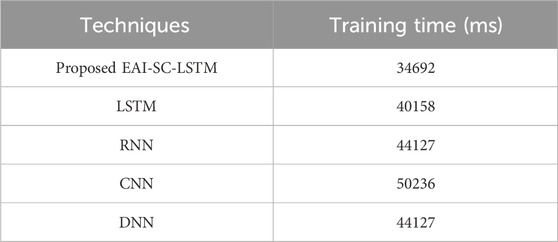
Table 5. Analysis of Proposed EAI-SC-LSTM and Existing Techniques in SSC Dataset based on Training Time.
As shown in Figure 4, the Area Under Curve (AUC) comparison for SMS phishing detection demonstrates that the proposed EAI-SC-LSTM model achieves the highest performance with an AUC of 0.99. It outperforms traditional models, such as LSTM (0.96), RNN (0.94), CNN (0.90), and DNN (0.89), highlighting its superior capability in distinguishing phishing messages with high true positive rates.
Figure 5 represents a shape often seen in data visualization, symbolizing cycles or flow. In the SPCA Variance Graph for SMS Phishing Detection, individual variance (blue line) starts high but declines, while cumulative variance (orange line) increases, reaching 1.0 by the 4th principal component. This shows how SPCA reduces dimensions while preserving crucial data for detecting phishing patterns efficiently.
4.2.1.2 Analysis with PEC dataset
The performance of both the proposed and existing classifiers is evaluated using the PEC dataset, which is detailed below.
In Figure 6, the assessment of the proposed classifier on the PEC dataset is presented, showcasing its performance regarding Positive Predictive Value (PPV), Negative Predictive Value (NPV), sensitivity, specificity, and accuracy for classifying phishing and legitimate data. By minimizing the gradient explosion problem via the introduced SERF CoLU activation function, the proposed model learns the complex data features. Figure 6 shows that the EAI-SC-LSTM attains 99.652% PPV, 99.326% NPV, 99.874% sensitivity, 99.857% specificity, and 99.645% accuracy, which are higher than the prevailing networks. Simultaneously, the existing networks like RNN achieve 96.857% PPV and 93.845% accuracy, CNN obtains 87.847% NPV and 91.689% sensitivity, and DNN attains 91.987% PPV and 88.9655 specificity. Hence, it is verified that when compared to other conventional techniques, the proposed classifier provides increased performance.
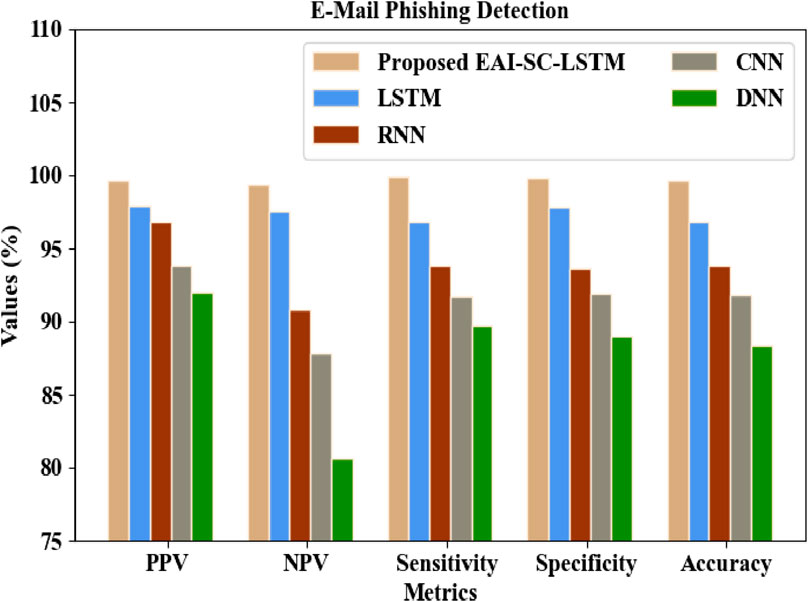
Figure 6. Performance assessment of the proposed EAI-SC-LSTM and existing techniques for detecting the phishing attacks.
Table 6 upresents the training time analysis of the proposed EAI-SC-LSTM on the PEC dataset. The Proposed EAI-SC-LSTM achieved the lowest training time of 24417 ms, outperforming LSTM (30265 ms), RNN (35265 ms), CNN (40157 ms), and DNN (44784 ms). This reduction is due to the use of the efficient SERF-CoLU activation function, which accelerates convergence in the proposed classifier.
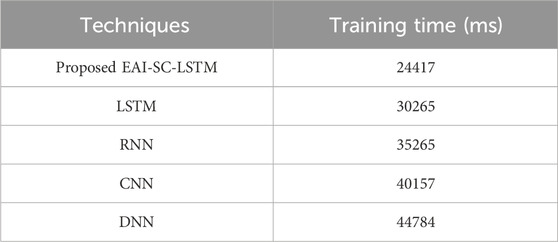
Table 6. Training time analysis for the proposed EAI-SC-LSTM and existing techniques in the PEC dataset.
As depicted in Figure 7, for E-Mail phishing detection, the proposed EAI-SC-LSTM model attains the highest AUC value of 0.99, indicating excellent classification ability. In comparison, LSTM attained an AUC of 0.96, RNN at 0.93, CNN at 0.91, and DNN at 0.88, showing that the proposed method significantly improves detection performance over conventional approaches.
Figure 8 represents a graph that helps analyze variance in data. In the SPCA Variance Graph for E-Mail Phishing Detection, individual variance is highest for the first principal component and gradually decreases, while cumulative variance rises steadily, approaching 1.0 by nearly the 14th principal component. This demonstrates how SPCA effectively reduces dimensions while retaining key information for accurate phishing detection.
4.2.1.3 Analysis with WPD dataset
An evaluation of the proposed and existing classifiers is conducted using the WPD dataset, as outlined below.
Regarding accuracy, True Positive Rate (TPR), True Negative Rate (TNR), False Positive Rate (FPR), and False Negative Rate (FNR), the performance of EAI-SC-LSTM is analyzed for the WPD dataset, which is displayed in Table 7. The proposed approach achieves 99.541% accuracy, 99.865% TPR, 99.562% TNR, 0.587% FPR, and 0.635% FNR. Meanwhile, the prevailing techniques attain an average accuracy, TNR, TPR, FPR, and FNR of 96.156%, 95.903%, 95.055%, 5.616%, and 5.387%, correspondingly, which are better than the proposed technique. Since various features, including user behavior, are analyzed and embedded prior to classification, the EAI-SC-LSTM detects phishing data with better performance than the prevailing approaches.

Table 7. Performance analysis of TPR, TNR, accuracy, FPR, and FNR for the proposed EAI-SC-LSTM and the existing techniques.
Figure 9 analyzes the AUC measure of the proposed EAI-SC-LSTM and the prevailing networks. The capability of the network is determined by the AUC to accurately categorize the phishing and legitimate data. Figure 9 displays that the proposed network attains a higher AUC value (0.99) than the prevailing networks. The existing networks like LSTM, RNN, CNN, and DNN attain lower AUC measures of 0.97, 0.94, 0.92, and 0.89, respectively. Since different features that comprise user behavior, contents, Javascript, and URL structures are analyzed for training the classifier, the proposed model more accurately detects the legitimate and phishing classes than the prevalent networks.
In Table 8, the supremacy of the proposed EAI-SC-LSTM model regarding training time for phishing detection is depicted. Table 8 exhibits that the proposed model takes a lesser duration (38965 ms) for training. However, the prevailing approaches, namely, LSTM, RNN, CNN, and DNN take 45712 ms, 50698 ms, 55847 ms, and 60254 ms for training, respectively. Thus, they consume more time than the proposed classifier. As the optimal features are chosen centered on maximum accuracy before training the model, they help in faster training of the classifier. Therefore, the proposed model attains enhanced performance than other existing methods.
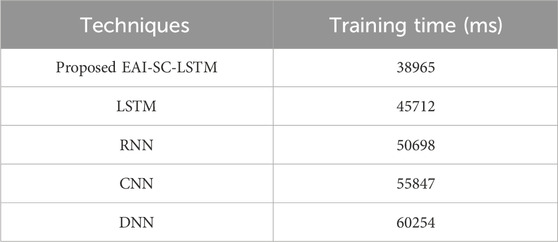
Table 8. Analysis of the Proposed EAI-SC-LSTM and the Existing Techniques in terms of Training Time.
Figure 10 represents a graph that visualizes variance distribution in data. In the SPCA Variance Graph for URL Phishing Detection, individual variance (blue circles) decreases across principal components, while cumulative variance (orange squares) steadily rises, approaching 1.0 by the 10th component. This highlights how SPCA efficiently reduces dimensions and maintains critical information for detecting phishing threats.
4.2.2 Performance evaluation of CSOA
The performance of the proposed CSOA is evaluated with existing approaches for feature selection.
Table 9 evaluates the performance of CSOA in selecting the important features with respect to the feature selection time. The performance of CSOA is examined by comparing it with other algorithms, namely, SOA, Fish Swarm Optimization Algorithm (FSOA), Whale Optimization Algorithm (WOA), and Particle Swarm Optimization Algorithm (PSOA). It is observed that the proposed CSOA chooses optimal features within 3625 ms for 10 iterations and 12874 ms for 40 iterations, which are lesser than the prevailing algorithms. In the meantime, the prevailing FSOA takes 11784 ms, WOA consumes 15639 ms, and PSOA takes 19865 ms for 10 iterations. Moreover, during feature selection, the prevailing FSOA and WOA take 20685 ms and 24865 ms for 40 iterations, correspondingly. The proposed algorithm takes minimal time to choose the optimal features since the premature convergence problem of SOA is resolved by updating the seagull position using CDF. Hence, when compared to other traditional algorithms, the proposed CSOA attains enhanced performance.
4.3 Comparative analysis with related works
Based on accuracy, precision, and recall, the proposed phishing detection framework is compared with some existing works for validating the enhanced performance.
Table 10 displays the comparison of the performance of phishing detection using the proposed technique and other related works. It is found that the proposed model achieves accuracies of 99.625% on the SSC dataset, 99.645% on the PEC dataset, and 99.541% on the WPD dataset. Also, the SSC dataset attains a precision of 99.895% and an F-measure of 99.541%, demonstrating high overall performance. In the meantime, the prevailing approaches, namely, RF achieves 98.90% accuracy, Functional Tree-based Meta-Learning (FTML) attains 98.50% f-measure, LSTM-CNN obtains 98.02% precision, Multistage Detection based on Different Features (MDDF) achieves 96.59% f-measure, ML algorithms attain 96.30% accuracy, AntiPhishStack-LSTM model achieved 98.01 precision, Decision Tree and Random Forest (DT+RF) achieved 97.44 accuracy, and Gated Recurrent Unit (GRU) obtained 98.8 f-measure. These prevailing works don’t examine the multiple data sources as well as the user behavior for phishing detection. However, the proposed work considers user behavior and Java script features of various data sources for phishing detection. Also, the proposed model included the integration of SMS, email, and URL data. Further, in the proposed system, the phishing attack was detected with transparency and interpretability. Hence, when compared to the prevailing works, the proposed system attains enhanced performance regarding phishing attack detection.
4.4 Comparative analysis with dataset
The comparison of similar studies regarding phishing attack detection with the dataset used in the proposed work is shown in Table 11.
As shown in Table 11, the proposed model achieves high accuracy across datasets like 99.625% (SSC), 99.645% (PEC), and 99.541% (WPD) with an F-measure of 99.562% on the SSC dataset, confirming its effective phishing detection. This is because of the utilization of selected features, SC activation function, and EAI technique. However, the existing studies that use a similar dataset with classifier models like LSTM, AdaBoost (ADB), and eXtreme Gradient Boosting (XGB) show poor performance than the proposed system. The traditional techniques fail to analyze the important features or depend on one source, leading to lower accuracy, precision, recall, and F-measure. Thus, the proposed research work effectively detects the phishing attacks than the prevailing studies.
4.5 Computational Complexity Analysis
The time spent for the purpose of phishing attack detection is analyzed and depicted in Figure 11. Mostly, the Big O notation is used to describe the time complexity of the proposed model and the prevailing models regarding the performance characteristics while dealing with the input data.
As the SC activation function and the EAI are used by the proposed classifier, effective phishing attack detection in the multimodal data is done, thus avoiding the vanishing gradient problem. Hence, the proposed EAI-SC-LSTM classifier achieves a Big O notation of O(1), which shows that phishing attack detection is effective and quick. But, the existing LSTM attains O(n), the RNN achieves O(n log n), the CNN obtains O(n^2), and the DNN achieves O(2^n) Big O notation during phishing attack prediction. This proves that the runtime of the proposed classifier is lower than the existing classifiers. Hence, the usage of SC and the EAI technique in the proposed work does not produce computational complexity.
4.6 Discussion
As per the performance assessment of the proposed model, the phishing attacks in the multiple data sources were analyzed precisely. The features of the input data were converted to vector form using EM-BERT. Then, the important features were selected using CSOA, which attained a feature selection time of 3625 ms for 10 iterations and 15698 ms for 50 iterations. With the help of the extracted feature and the vector form data, the proposed EAI-SC-LSTM classified the phishing attack with an accuracy of 99.645% (PEC) and a precision of 99.895% (SSC). However, the existing models, as mentioned in the performance assessment, could not attain more effective results than the proposed models. Also, in the comparison of the proposed work and the prevailing works regarding phishing attack detection, the proposed work attained better results. Hence, the proposed work played an effective role in phishing attack detection for multiple data sources.
4.7 T-test analysis
The T-test analysis of the dataset distribution for the proposed framework that addresses the statistical significance is illustrated in Figure 12.
The above Figure 12 visualizes the distribution of values within the dataset. Here, the vertical dashed line indicates the sample mean. A one-sample-based T-test was conducted to check the deviation of the sample mean from the expected baseline. Thus, the T-test attained a T-score of −3.1993 and a P-value of 0.0015, showing statistically significant differences at the level of 0.05. Thus, it proves that the observed dataset values have occurred effectively and not by random chance. Thereby, this supports the hypothesis that the datasets used in the proposed work exhibit meaningful deviation concerning the assumed baseline. Hence, the robustness of the observed values is achieved.
4.8 Limitation
Although the proposed work efficiently analyzed the phishing attack in sources like SMS, email, and web page URLs, it failed to perform the Secure Sockets Layer (SSL) certificate analysis. The attacker uses this SSL certificate and makes the phishing site appear to be a secured one.
5 Conclusion
This work proposed an effective multimodal framework for phishing detection using EAI-SC-LSTM, CSOA, and SPCA approaches. The proposed approach used multiple data sources and examined various features like user behavior of the data. In addition, by using the proposed EM-BERT algorithm, the vector conversion of features enhanced the classifier learning. Then, by utilizing the presented CSOA, the optimal features of the URL were selected with a suitable fitness of 99.68% for 50 iterations. Hence, by using the proposed EAI-SC-LSTM model, the phishing and legitimate data were detected with an accuracy of 99.645% (PEC), a precision of 99.895% (SSC), recall of 99.784% (SSC), PPV of 99.652% (PEC), FNR of 0.6359, and training time of 24417 ms (PEC). Thus, the proposed model provided an enhanced system for phishing detection and mitigation of multisource data. This implied that the proposed EAI-SC-LSTM technique surpassed the traditional phishing detection models. The integration of the real-time blacklist update mechanism into the proposed system enhanced the system’s reliability in adapting to the evolving phishing attack. The results attained by the proposed system made the model to be a promising solution for real-time cybersecurity applications.
5.1 Future work
Although the behavior features are efficiently used for phishing detection, there is a possibility of developing Secure Sockets Layer (SSL) certificates for the malicious domains by the attackers. This is a limitation of this research. So, in the future, SSL certificate analysis will be incorporated to improve the phishing attack detection accuracy and to enhance the security of the system against other sophisticated attacks. Hence, the proposed work will further improve the robustness in real-world scenarios.
Data availability statement
The original contributions presented in the study are included in the article/Supplementary Material, further inquiries can be directed to the corresponding author.
Author contributions
MM: Conceptualization, Data curation, Investigation, Methodology, Software, Validation, Writing – original draft. GN: Supervision, Writing – review and editing.
Funding
The author(s) declare that no financial support was received for the research and/or publication of this article.
Acknowledgments
We thank the referees for their useful suggestions.
Conflict of interest
The authors declare that the research was conducted in the absence of any commercial or financial relationships that could be construed as a potential conflict of interest.
Generative AI statement
The author(s) declare that no Generative AI was used in the creation of this manuscript.
Publisher’s note
All claims expressed in this article are solely those of the authors and do not necessarily represent those of their affiliated organizations, or those of the publisher, the editors and the reviewers. Any product that may be evaluated in this article, or claim that may be made by its manufacturer, is not guaranteed or endorsed by the publisher.
Supplementary material
The Supplementary Material for this article can be found online at: https://www.frontiersin.org/articles/10.3389/frcmn.2025.1587654/full#supplementary-material
References
Abdillah, R., Shukur, Z., Mohd, M., and Murah, T. M. Z. (2022). Phishing classification techniques: a systematic literature review. IEEE Access 10, 41574–41591. doi:10.1109/ACCESS.2022.3166474
Akour, I., Alnazzawi, N., Aburayya, A., Alfaisal, R., and Salloum, S. A. (2021). Using Classical Machine Learning for phishing websites detection form URLS. J. Manag. Inf. Decis. Sci. 24 (6), 1–9.
Al-Ahmadi, S., Alotaibi, A., and Alsaleh, O. (2022). PDGAN: phishing detection with generative adversarial networks. IEEE Access 10, 42459–42468. doi:10.1109/ACCESS.2022.3168235
Aljabri, J., Alzaben, N., Nemri, N., Alahmari, S., Alotaibi, S. D., Alazwari, S., et al. (2024). Hybrid stacked autoencoder with dwarf mongoose optimization for Phishing attack detection in internet of things environment. Alexandria Eng. J. 106, 164–171. doi:10.1016/j.aej.2024.06.070
Aljofey, A., Jiang, Q., Rasool, A., Chen, H., Liu, W., Qu, Q., et al. (2022). An effective detection approach for phishing websites using URL and HTML features. Sci. Rep. 12 (1), 8842–19. doi:10.1038/s41598-022-10841-5
Alotaibi, S. R., Alkahtani, H. K., Aljebreen, M., Alshuhail, A., Saeed, M. K., Ebad, S. A., et al. (2025). Explainable artificial intelligence in web phishing classification on secure IoT with cloud-based cyber-physical systems. Alexandria Eng. J. 110, 490–505. doi:10.1016/j.aej.2024.09.115
Alsubaei, F. S., Almazroi, A. A., and Ayub, N. (2024). Enhancing phishing detection: a novel hybrid deep learning framework for cybercrime forensics. IEEE Access 12, 8373–8389. doi:10.1109/ACCESS.2024.3351946
Ariyadasa, S., Fernando, S., and Fernando, S. (2022). Combining long-term recurrent convolutional and graph convolutional networks to detect phishing sites using URL and HTML. IEEE Access 10, 82355–82375. doi:10.1109/ACCESS.2022.3196018
Asiri, S., Xiao, Y., Alzahrani, S., Li, S., and Li, T. (2023). A survey of intelligent detection designs of HTML URL phishing attacks. IEEE Access 11, 6421–6443. doi:10.1109/ACCESS.2023.3237798
Aslam, S., Aslam, H., Manzoor, A., Chen, H., and Rasool, A. (2024). AntiPhishStack: LSTM-based stacked generalization model for optimized phishing URL detection. Symmetry 16 (2), 248–25. doi:10.3390/sym16020248
Atlam, H. F., and Oluwatimilehin, O. (2023). Business email compromise phishing detection based on machine learning: a systematic literature review. Electron. Switz. 12 (1), 42–28. doi:10.3390/electronics12010042
Balogun, A. O., Adewole, K. S., Raheem, M. O., Akande, O. N., Usman-Hamza, F. E., Mabayoje, M. A., et al. (2021). Improving the phishing website detection using empirical analysis of Function Tree and its variants. Heliyon 7 (7), e07437–14. doi:10.1016/j.heliyon.2021.e07437
Basit, A., Zafar, M., Liu, X., Javed, A. R., Jalil, Z., and Kifayat, K. (2021). A comprehensive survey of AI-enabled phishing attacks detection techniques. Telecommun. Syst. 76 (1), 139–154. doi:10.1007/s11235-020-00733-2
Bhagwat, M. D., Patil, P. H., and Vishawanath, T. S. (2021). “A methodical overview on detection identification and proactive prevention of phishing websites,” in Proceedings of the 3rd International Conference on Intelligent Communication Technologies and Virtual Mobile Networks, 1505–1508. doi:10.1109/ICICV50876.2021.9388441
Biswas, B., Mukhopadhyay, A., Kumar, A., and Delen, D. (2024). A hybrid framework using explainable AI (XAI) in cyber-risk management for defence and recovery against phishing attacks. Decis. Support Syst. 177, 114102. doi:10.1016/j.dss.2023.114102
Brezeanu, G., Archip, A., and Artene, C. G. (2025). Phish fighter: self updating machine learning shield against phishing kits based on HTML code analysis. IEEE Access 13, 4460–4486. doi:10.1109/ACCESS.2025.3525998
Bu, S. J., and Kim, H. J. (2022). Optimized URL feature selection based on genetic-algorithm-embedded deep learning for phishing website detection. Electron. Switz. 11 (7), 1090–12. doi:10.3390/electronics11071090
Catal, C., Giray, G., Tekinerdogan, B., Kumar, S., and Shukla, S. (2022). Applications of deep learning for phishing detection: a systematic literature review. Knowl. Inf. Syst. 64 (6). 1457-1500. doi:10.1007/s10115-022-01672-x
Champa, A. I., Rabbi, F., and Zibran, M. F. (2024a). “Why phishing emails escape detection: a closer look at the failure points,” in 2024 12th international symposium on digital forensics and security (ISDFS) (IEEE), 1–6. Available online at: https://www2.cose.isu.edu/∼minhazzibran/resources/MyPapers/Champa_ISDFS24_Published.pdf.
Champa, A. I., Rabbi, M. F., and Zibran, M. F. (2024b). “Curated datasets and feature analysis for phishing email detection with machine learning,” in IEEE 3rd International Conference on Computing and Machine Intelligence (ICMI) (IEEE), 1–7. Available online at: https://ieeexplore.ieee.org/abstract/document/10585821/.
Elberri, M. A., Tokeşer, Ü., Rahebi, J., and Lopez-Guede, J. M. (2024). A cyber defense system against phishing attacks with deep learning game theory and LSTM-CNN with African vulture optimization algorithm (AVOA). Int. J. Inf. Secur. 23, 2583–2606. doi:10.1007/s10207-024-00851-x
Gupta, B. B., Yadav, K., Razzak, I., Psannis, K., Castiglione, A., and Chang, X. (2021). A novel approach for phishing URLs detection using lexical based machine learning in a real-time environment. Comput. Commun. 175, 47–57. doi:10.1016/j.comcom.2021.04.023
Hannousse, A., and Yahiouche, S. (2021). Towards benchmark datasets for machine learning based website phishing detection: an experimental study. Eng. Appl. Artif. Intell. 104, 104347–17. doi:10.1016/j.engappai.2021.104347
Kara, I., Ok, M., and Ozaday, A. (2022). Characteristics of understanding URLs and domain names features: the detection of phishing websites with machine learning methods. IEEE Access 10, 124420–124428. doi:10.1109/ACCESS.2022.3223111
Karim, A., Shahroz, M., Mustofa, K., Belhaouari, S. B., and Joga, S. R. K. (2023). Phishing detection system through hybrid machine learning based on URL. IEEE Access 11, 36805–36822. doi:10.1109/ACCESS.2023.3252366
Li, W., Manickam, S., Laghari, S. U. A., and Chong, Y. W. (2023). Uncovering the cloak: a systematic review of techniques used to conceal phishing websites. IEEE Access 11, 71925–71939. doi:10.1109/ACCESS.2023.3293063
Liu, D. J., Geng, G. G., Jin, X. B., and Wang, W. (2021). An efficient multistage phishing website detection model based on the CASE feature framework: aiming at the real web environment. Comput. Secur. 110, 102421–14. doi:10.1016/j.cose.2021.102421
Mahmoud, T. M., Abd-El-Hafeez, T., and Badawy, A. (2013). A framework for an E-learning system based on semantic web. Int. J. Comput. Sci. Eng. 5 (8), 698.
Mehmood, M. K., Arshad, H., Alawida, M., and Mehmood, A. (2024). Enhancing smishing detection: a deep learning approach for improved accuracy and reduced False positives. IEEE Access 12, 137176–137193. doi:10.1109/ACCESS.2024.3463871
Naqvi, B., Perova, K., Farooq, A., Makhdoom, I., Oyedeji, S., and Porras, J. (2023). Mitigation strategies against the phishing attacks: a systematic literature review. Comput. Secur. 132, 103387–25. doi:10.1016/j.cose.2023.103387
Odeh, A., Keshta, I., and Abdelfattah, E. (2021). “Machine LearningTechniquesfor detection of website phishing: a review for promises and challenges,” in 11th Annual Computing and Communication Workshop and Conference, 0813–0818. doi:10.1109/CCWC51732.2021.9375997
Opara, C., Chen, Y., and Wei, B. (2024). Look before you leap: detecting phishing web pages by exploiting raw URL and HTML characteristics. Expert Syst. Appl. 236, 121183–13. doi:10.1016/j.eswa.2023.121183
Rao, R. S., Pais, A. R., and Anand, P. (2021). A heuristic technique to detect phishing websites using TWSVM classifier. Neural Comput. Appl. 33 (11), 5733–5752. doi:10.1007/s00521-020-05354-z
Rashid, S. H., and Abdullah, W. D. (2023). Cloud-based machine learning approach for accurate detection of website phishing. Int. J. Intell. Syst. Appl. Eng. 11, 451–460. Available online at: https://www.researchgate.net/publication/373659846_Cloud-Based_Machine_Learning_Approach_for_Accurate_Detection_of_Website_Phishing?enrichId=rgreq-c5186a18cbf358037766b257b86e931f-XXX&enrichSource=Y292ZXJQYWdlOzM3MzY1OTg0NjtBUzoxMTQzMTI4MTE4NjM3NTg0OUAxNjkzOTA1MzMxNjM3&el=1_x_3&_esc=publicationCoverPdf
Safi, A., and Singh, S. (2023). A systematic literature review on phishing website detection techniques. J. King Saud Univ. - Comput. Inf. Sci. 35 (2), 590–611. doi:10.1016/j.jksuci.2023.01.004
Sahingoz, O. K., Bube, E., and Kugu, E. (2024). Dephides: deep learning based phishing detection system. IEEE Access 12, 8052–8070. doi:10.1109/ACCESS.2024.3352629
Salloum, S., Gaber, T., Vadera, S., and Shaalan, K. (2021). Phishing email detection using Natural Language Processing techniques: a literature survey. Procedia Comput. Sci. 189, 19–28. doi:10.1016/j.procs.2021.05.077
Salloum, S., Gaber, T., Vadera, S., and Shaalan, K. (2022). A systematic literature review on phishing email detection using Natural Language Processing techniques. IEEE Access 10, 65703–65727. doi:10.1109/ACCESS.2022.3183083
Sanchez-Paniagua, M., Fidalgo, E., Alegre, E., and Alaiz-Rodriguez, R. (2022). Phishing websites detection using a novel multipurpose dataset and web technologies features. Expert Syst. Appl. 207, 118010–118016. doi:10.1016/j.eswa.2022.118010
Shafin, S. S. (2024). An explainable feature selection framework for web phishing detection with machine learning. Data Sci. Manag. 8, 127–136. doi:10.1016/j.dsm.2024.08.004
Shombot, E. S., Dusserre, G., Bestak, R., and Ahmed, N. B. (2024). An application for predicting phishing attacks: a case of implementing a support vector machine learning model. Cyber Secur. Appl. 2, 100036. doi:10.1016/j.csa.2024.100036
Sturman, D., Auton, J. C., and Morrison, B. W. (2024). Security awareness, decision style, knowledge, and phishing email detection: moderated mediation analyses. Comput. & Secur. 148, 104129. doi:10.1016/j.cose.2024.104129
Sudar, K. M., Rohan, M., and Vignesh, K. (2024). Detection of adversarial phishing attack using machine learning techniques. Sādhanā 49 (3), 232. doi:10.1007/s12046024025820
Tang, L., and Mahmoud, Q. H. (2021). A survey of machine learning-based solutions for phishing website detection. Mach. Learn. Knowl. Extr. 3 (3), 672–694. doi:10.3390/make3030034
Tang, L., and Mahmoud, Q. H. (2022). A deep learning-based framework for phishing website detection. IEEE Access 10, 1509–1521. doi:10.1109/ACCESS.2021.3137636
Thakur, K., Ali, M. L., Obaidat, M. A., and Kamruzzaman, A. (2023). A systematic review on deep-learning-based phishing email detection. Electron. Switz. 12 (21), 4545–26. doi:10.3390/electronics12214545
van Geest, R. J., Cascavilla, G., Hulstijn, J., and Zannone, N. (2024). The applicability of a hybrid framework for automated phishing detection. Comput. Secur. 139, 103736–17. doi:10.1016/j.cose.2024.103736
Keywords: short message service (SMS), java script, electronic mail (e-mail), user behavior, uniform resource locator (URL), cascading style sheets (CSS), phishing attack, and artificial
Citation: Murhej M and Nallasivan G (2025) Multimodal framework for phishing attack detection and mitigation through behavior analysis using EM-BERT and SPCA-BASED EAI-SC-LSTM. Front. Commun. Netw. 6:1587654. doi: 10.3389/frcmn.2025.1587654
Received: 06 March 2025; Accepted: 05 June 2025;
Published: 08 July 2025.
Edited by:
Kuo-Hui Yeh, National Yang Ming Chiao Tung University, TaiwanReviewed by:
Abdur Rasool, University of Hawaii at Manoa, United StatesRevathi S, VIT University, India
Copyright © 2025 Murhej and Nallasivan. This is an open-access article distributed under the terms of the Creative Commons Attribution License (CC BY). The use, distribution or reproduction in other forums is permitted, provided the original author(s) and the copyright owner(s) are credited and that the original publication in this journal is cited, in accordance with accepted academic practice. No use, distribution or reproduction is permitted which does not comply with these terms.
*Correspondence: Mahmoud Murhej, bWFobW91ZG1yaGVqQGdtYWlsLmNvbQ==; G. Nallasivan, ZHJuYWxsYXNpdmFuZ0B2ZWx0ZWNoLmVkdS5pbg==
†ORCID: Mahmoud Murhej, orcid.org/0009-0004-8330-0128; G. Nallasivan, orcid.org/0000-0001-7852-6713
 Mahmoud Murhej
Mahmoud Murhej G. Nallasivan*†
G. Nallasivan*†